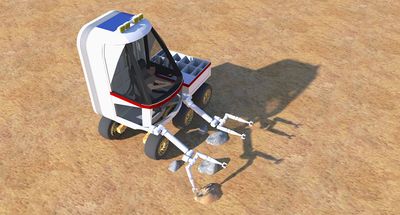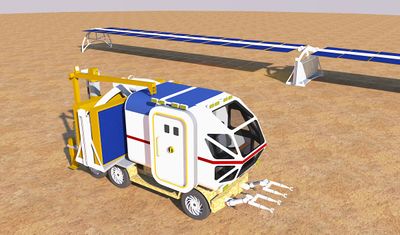Difference between revisions of "Mineralogical exploration"
| Line 14: | Line 14: | ||
*[[Water]] ice | *[[Water]] ice | ||
*Concentrated minerals (iron oxides, copper oxides, alumina, Thorium, Uranium) | *Concentrated minerals (iron oxides, copper oxides, alumina, Thorium, Uranium) | ||
| + | **[[Crater|Crater impacts]], in particular for heavy elements or elements that are not miscible with others | ||
| + | **[[Volcano|Volcanic hydrothermal vents]], for heavier elements as well | ||
| + | **Clays may be good sources for alumina and other light oxides | ||
*Pure salts (chlorine, lithium, sodium, potassium) | *Pure salts (chlorine, lithium, sodium, potassium) | ||
*Iron meteorites (iron, nickel, cobalt, other metals in non oxidized forms) | *Iron meteorites (iron, nickel, cobalt, other metals in non oxidized forms) | ||
Revision as of 08:39, 16 November 2020
Mineralogical exploration is already underway on Mars using the various rovers sent by the US and remote sensing from orbital probes. More intensive exploration can be carried out in the future using, first, dedicated rovers and then human explorers. Analysis could be carried out in-situ, but also in a well equipped lab at a Martian base.
Mineralogical exploration will also be done in parallel with the search for life, as it will use the same exploration and manipulation tools, but, in part, different analysis equipment. Exploration is a precursor step to mining on Mars.
Mineralogical remote controlled rover
A martian exploration mission will include some kind of mineralogical exploration rover. This vehicle will need to be able to extract samples and bring them back to a laboratory for analysis, or perform these analysis itself. Probably battery powered, the vehicle would need to be able to connect itself to a power supply to recharge the batteries. This would greatly increase the rapidity and capacities compared to existing rovers.
Mineralogical human exploration
For fast exploration, a human presence will be vastly superior to robotic exploration. Decisions can be made on the spot and manipulators can be controlled directly. Geology is both a objective and subjective science, and experienced geologists can obtain better results than untrained personnel or machines.
Exploration objectives
Minerals are available everywhere on Mars but in dilute forms. The purpose of geological exploration will be to identify useful concentrations of minerals, for latter exploitation by the settlement. The first objective will be to identify the cleanest water source possible, to reduce processing before use. High concentrations of the following would be prime targets for research:
- Water ice
- Concentrated minerals (iron oxides, copper oxides, alumina, Thorium, Uranium)
- Crater impacts, in particular for heavy elements or elements that are not miscible with others
- Volcanic hydrothermal vents, for heavier elements as well
- Clays may be good sources for alumina and other light oxides
- Pure salts (chlorine, lithium, sodium, potassium)
- Iron meteorites (iron, nickel, cobalt, other metals in non oxidized forms)
- Pure silica deposits
- Carbonate deposits
- Clays
- Methane clathrates









